You know what’s worse than a product with a bad user experience? A beautifully crafted UX design that doesn’t work. Or a fully functional app that looks like it time-traveled from the early 2000s. If you've ever been caught between UI/UX design and development mockups and final builds that look like distant cousins, you know where this is going.
That’s why collaboration between UX designers and developers isn’t just a nice-to-have. It’s the foundation of creating digital experiences that work, wow, and don’t drive users (or team members) to rage-quit. Whether you're working with a UX design developer, a frontend engineer, or a full-stack team, the synergy matters.
Let’s dive deep into why this collaboration matters, what goes wrong, and how to make it work better. Grab your coffee, and let’s get real. Learn more about custom UI/UX design that supports this synergy.
Why Should Designers and Developers Even Talk?
Because Design and Function Are Not Separate Islands
A UX developer dreams up a smooth, beautiful login screen. Meanwhile, the engineering team is figuring out how to make that biometric animation work without freezing the app. When UX developers and engineers don’t communicate, one ends up frustrated, and the other ends up drinking too much coffee. Again.
UX design and development are two sides of the same coin. Without real developer collaboration, that coin becomes useless. Or worse, expensive.
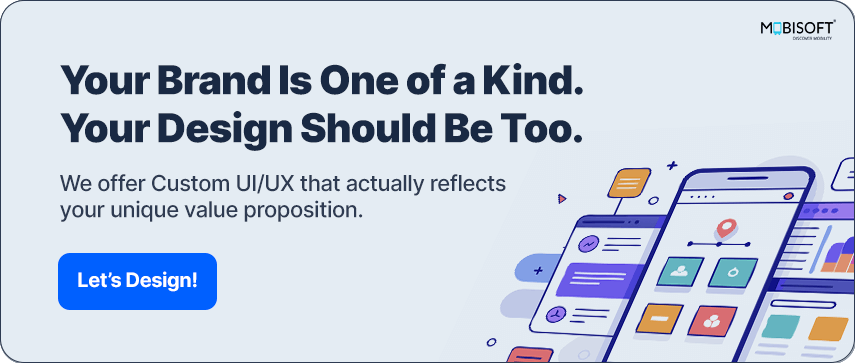
To Build Products Users Like
Users don’t care who made what. They care if it works. And they care if it’s easy to use. Good user experience design is invisible when it’s done right.
A clickable prototype that flows like butter means nothing if the live product loads like molasses. Good collaboration in the UX design process ensures that what’s designed can be built, and what’s built feels right.
To Save Time, Money, Sanity
Ever heard of "pixel-perfect" UX designs that had to be reworked for days because of technical constraints that weren’t discussed earlier?
Yeah. That.
Designers and developers working together from the beginning prevent teams from wasting hours redesigning or rewriting code. It's not magic. It's just being smart.
To Avoid the Game of Broken Telephone
You design. You hand it off. The developer builds. QA tests. Suddenly, the drop-down is a slide-in, and the hover effect has become a blink. Somewhere along the line, something got lost in translation.
Direct communication between UX designers and developers fixes that.
No middlemen. Fewer assumptions. Fewer bugs.
What Happens When They Don’t Collaborate?
Let’s paint a picture. It’s launch day. The app goes live. It looks... okay-ish. But within minutes, users are reporting crashes, confusion, and general chaos. Meanwhile, the designer is squinting at the live version, asking, "Why is the font Comic Sans?"
Here’s what can go wrong when there's no collaboration between designers and developers:
- Unrealistic UI/UX development requirements that are hard or impossible to code
- Inconsistent UI elements that confuse users
- Longer development cycles because of endless revisions
- Lower morale from finger-pointing and frustration
Here’s a quick snapshot of what typically goes wrong when UX design and development happen in silos:
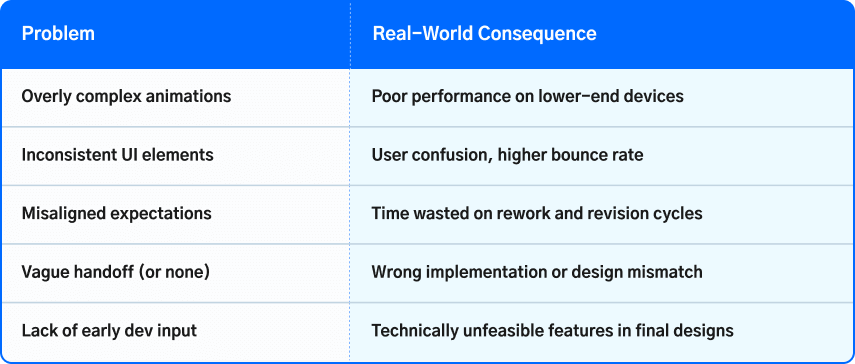
Most of these issues stem from a lack of clarity, not ability. Strong designer-developer collaboration clears them up early.
It’s like trying to bake a cake when the baker and the decorator never talked. You get a sponge that collapses under a mountain of frosting. Many of these issues can be prevented by following proven UX design best practices.
How to Make Collaboration Happen (Without Endless Meetings)
Let’s face it. Meetings are fine, but they’re not collaboration. Real collaboration happens through clear processes, team culture, and everyday habits.
Any successful UI/UX development company knows that frictionless cooperation between designers and developers is what drives real progress.
Involve Developers Early (No, Really Early)
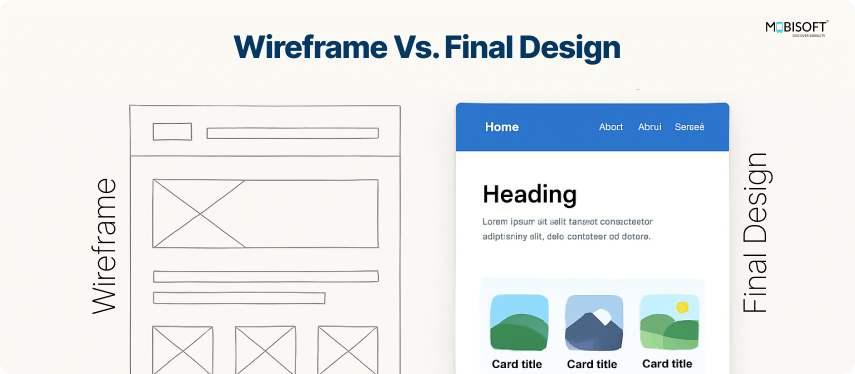
Don’t hand off fully baked designs and expect smooth sailing. Instead, bring developers into the design process from the sketching phase, a standard practice followed by top UI/UX design services.
Ask them things like:
- "Does this flow make sense technically?"
- "Can we build this animation without summoning dark magic?"
Their answers shape better UX design decisions. And you’ll avoid building castles in the sky.
Based on product team retrospectives and internal sprint audits, here’s where design-dev collaboration saves time:
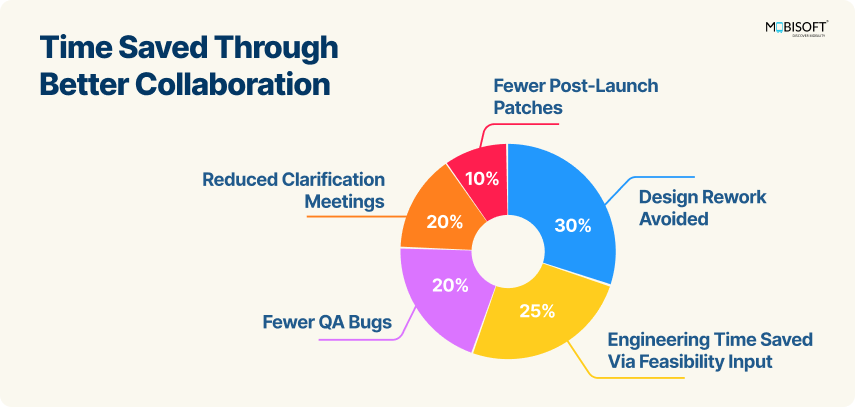
The Takeaway: Cross-functional alignment pays off long before go-live.
Speak the Same Language (Or Learn Enough to Ask Good Questions)
Designers don’t have to know how to write code. But understanding terms like API, responsiveness, or CSS grid makes conversations easier.
Same for developers. Learn about user flows, personas, and hierarchy. It helps you see the "why" behind the design.
Example: A designer learns about CSS breakpoints and stops making 12 different mockups for every screen size. The developer thanks them with actual cookies. It becomes even more effective when teams follow responsive web design principles.
In our UI UX development projects, we’ve found that small shared vocabulary changes lead to fewer misunderstandings and better results.
Developers cited these frequent frustrations during design handoffs:
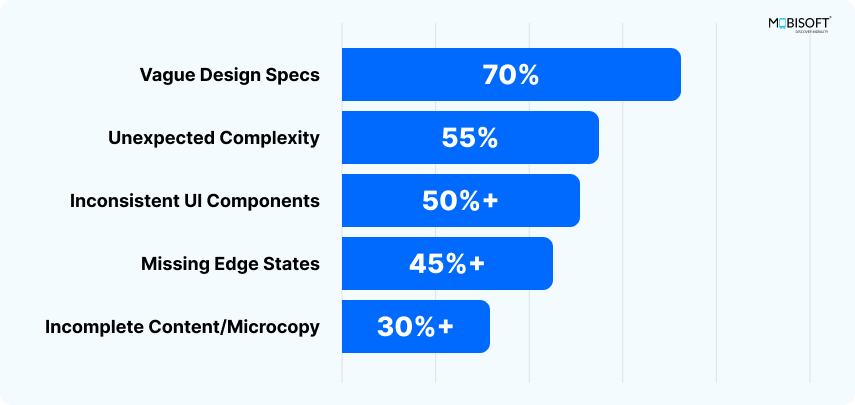
Most of these pain points can be eliminated through better alignment between design and engineering, especially when facilitated by experienced UI/UX development companies.
Use Shared Tools (Seriously, This One’s Big)
Design systems. Component libraries. Design tokens. These are more than just buzzwords; they’re the shared language between design and development teams in any mature UI/UX design services setup.
Use tools that bridge the gap:
- Figma and Zeplin for design handoff
- Storybook for reusable components
- Design tokens for shared colors, fonts, and spacing
When both sides use the same tools, fewer words get lost in translation. It’s one of the foundational reasons to hire UI/UX designers who are fluent in these modern workflows.
All this works best when supported by solid design system best practices.
Make Feedback Loops the Norm
Forget annual reviews or launch-day surprises. Make feedback continuous.
Set up:
- Weekly design-dev syncs
- Pairing sessions
- Quick check-ins over Slack or Teams
Don’t wait until QA to say, “Hey, this isn’t what I meant.” Say it when the first lines of code are written. This agile mindset helps UI UX development teams avoid delays and bugs.
Celebrate Collaboration (Not Just Output)
Did the developer suggest a smarter layout for mobile? Did the designer simplify a component that saved hours of code? This is often seen in teams offering mobile app design services.
Celebrate that.
Make collaboration part of your culture. Reward teamwork, not just ship dates. This mindset is ingrained in high-performing UI/UX development companies and contributes directly to better product quality.
Real-World Wins From Designer-Developer Harmony
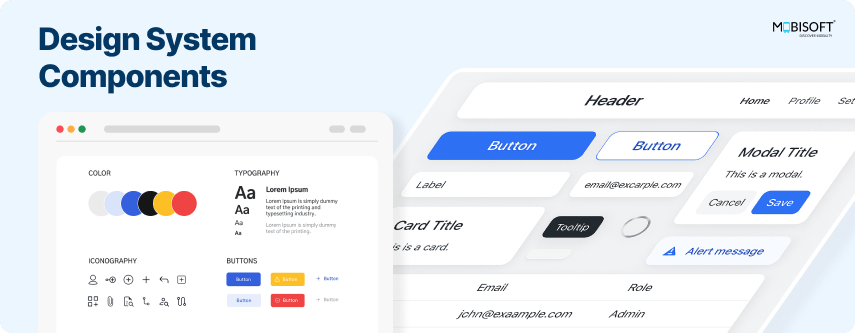
Let’s take a quick tour through some situations where collaboration paid off.
The Case of the Missing Button
A designer added a button for a feature that hadn’t been built yet. Instead of just deleting it, the developer asked why it was there. Turns out that users have been asking for this feature for weeks. They decided to build it.
Result: 20% increase in retention.
Animation vs. Performance
A fancy micro-interaction was causing lag on low-end devices. The designer and developer worked together to simplify the animation while also keeping its feel intact.
No lag. Happy users.
Copy That Made Sense
A developer caught a confusing label in a form during testing. Instead of changing it randomly, they pinged the designer. They rewrote it together. Drop-off on that form dropped by 15 percent.
These aren’t theoretical. They’re practical wins seen across projects where businesses choose to hire UI/UX designers who prioritize developer collaboration.
These practical wins reflect how successful teams prioritize communication and apply strong mobile app UX design strategies to elevate the user journey.
Add Supporting Details
Sometimes, not all interactions or effects can be shown perfectly in design tools due to their limitations. In such cases, designers can add comments in Figma or other design tools or maintain a simple spreadsheet explaining what the intended behavior is.
This proactive communication is a hallmark of effective UI/UX design services. Sharing this with developers before development starts keeps everyone on the same page and avoids unnecessary back-and-forth.
What Leaders Can Do to Encourage Collaboration

If you're a manager, team lead, or anyone with influence, here’s your cheat sheet to foster better designer and developer collaboration within your teams.
Break Down Silos
If your designers and developers sit on different floors (or worse, don’t talk at all), that’s a problem. Create mixed teams. Arrange standups where everyone hears everything.
Define Shared Goals
Tie success to outcomes, not roles. Don’t say, “The designer will finish the mockups by Friday.” Say, “We’ll have a testable version of the UX design user flow by Friday.”
Promote Empathy
Encourage team members to learn about each other’s work. Host "Dev 101" and "UX design 101" sessions.
Even 30-minute lunch-and-learns can do wonders in bridging gaps between UX developers and product teams.
Understanding of Timeline
Communicate the project timeline to both designers and developers. Align on what needs to go into production first and identify high-priority tasks.
Allow some flexibility so that if one task faces a roadblock, team members can shift to alternate tasks without disrupting overall progress.
Invest in the Right Tools
You don’t need every new shiny SaaS tool. But having the right ones helps. Pick tools that make collaboration easy, like:
- Shared project management boards
- Real-time UX design review tools
- Collaborative prototyping platforms
Celebrate the Process, Not Just the Result
Yes, shipping is important. But so is how you get there. Reward teams that work well together, not just individuals who hit deadlines.
Final Thoughts: Less Hand-Off, More Hand-In-Hand
We’re not building silos. We’re building experiences. And those experiences are only as good as the communication behind them.
When UX designers and developers collaborate:
- Products get built faster
- Users get happier
- Teams stay saner
You don’t need more meetings. You need more conversations. The informal Slack messages, the spontaneous whiteboard sessions, and the "Can I run something by you real quick?" moments between designers and developers working together make all the difference.
So the next time you’re tempted just to upload the design and walk away, pause. Send a message. Ask a question. Get feedback. Offer context.
Because a good UX collaboration isn’t just about working together, it is all about thinking together.
Let's build something awesome. Together.
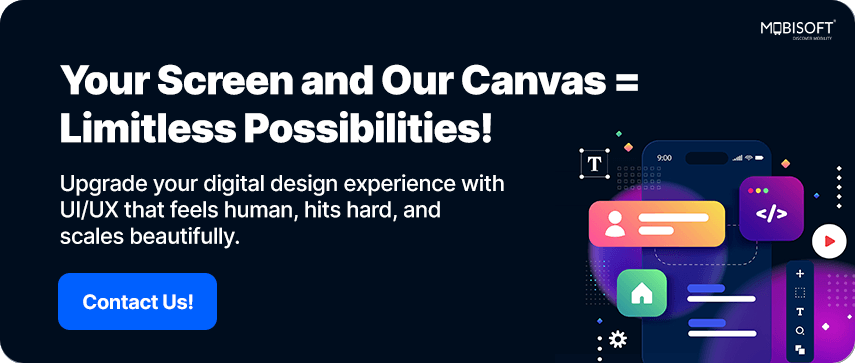

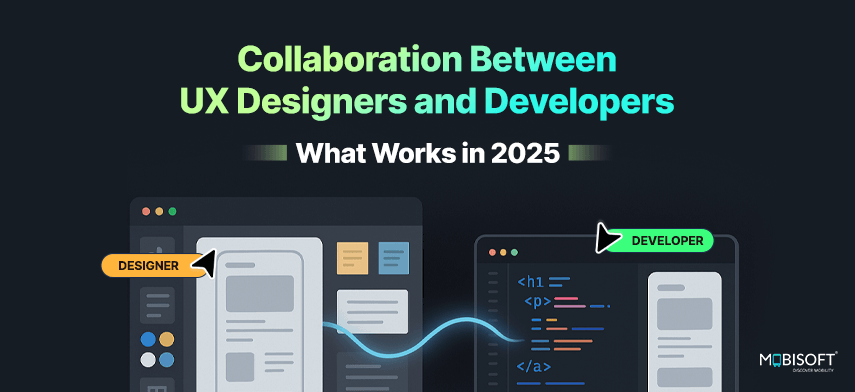


 May 26, 2025
May 26, 2025


